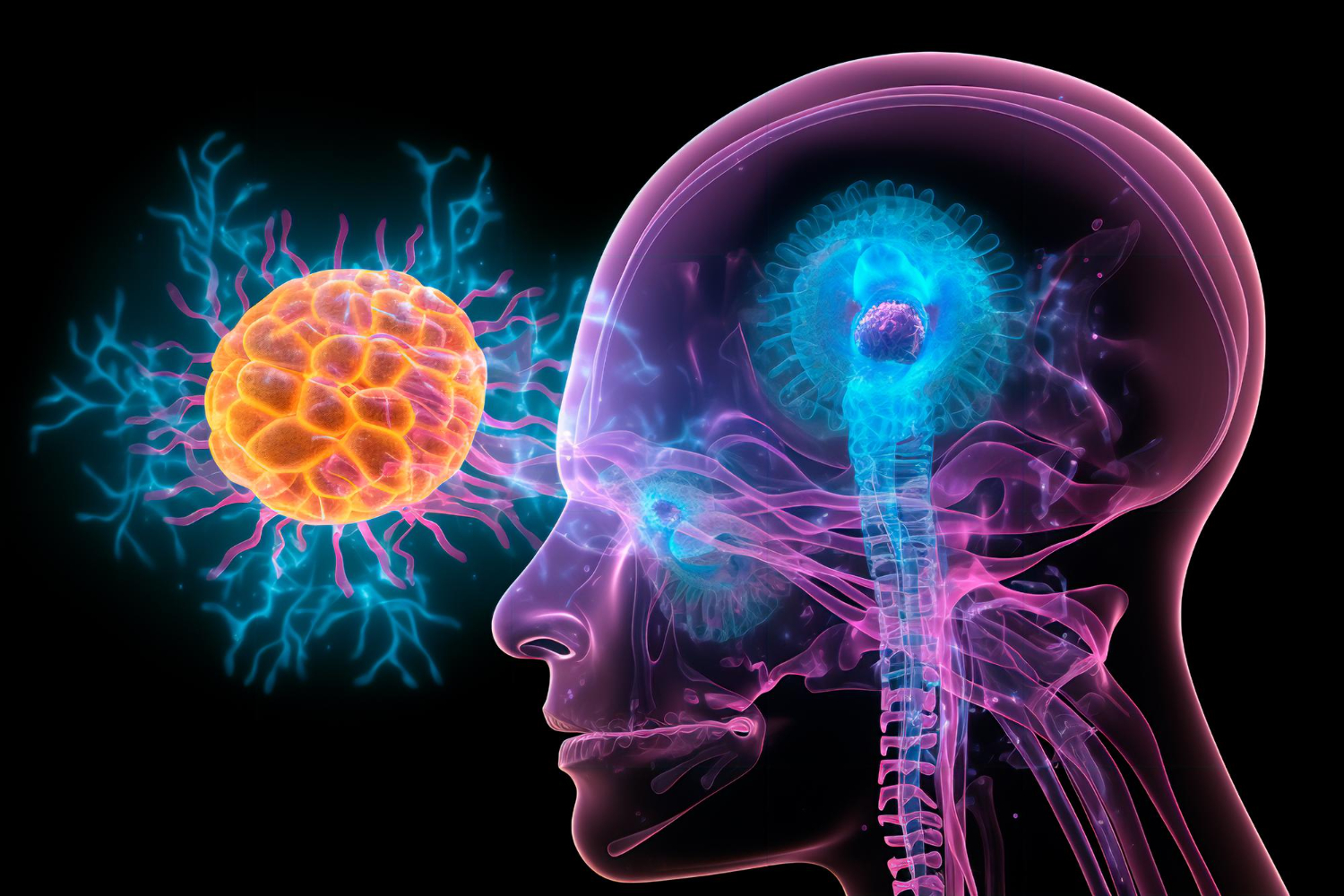
Case Study
New Treatment for Brain Tumor Uses Gene Silencing to Overcome Radioresistance
New Treatment for Brain Tumor Uses Gene Silencing to Overcome Radioresistance
Scientists developed a new technology for synthesizing and delivering anticancer drugs consisting of genetic material packed in a virus-like shell
Glioblastomas (GBMs)—a type of aggressive brain tumor—are known for their resistance to radiotherapy. To address this issue, a team of scientists recently developed an innovative anticancer drug delivery technology, in which multiple interfering RNA molecules were encapsulated within virus-like particles. Easy to synthesize, the RNA and capsules demonstrated promising results in mouse models treated with radiotherapy, paving the way for improved treatments for GBMs and other types of cancer.
Glioblastomas (GBMs) are a type of malignant and highly aggressive brain tumor originating from glial cells (the supportive cells of the brain). GBMs have remained a largely unsolved challenge in cancer therapy owing to their aggressive growth and resistance to radiotherapy treatments. Fortunately, with recent advances in nanotechnology involving the cancer’s genetic material, specifically the RNA, a beacon of hope has emerged on this front.
More specifically, scientists have come up with various methods to encapsulate small interfering RNAs (siRNAs) and microRNAs (miRNAs) into different types of nanoparticles to enhance delivery to tumor sites. Both siRNAs and miRNAs can be designed to target specific RNA sequences inside cells and interfere with their functions, thereby reducing the expression of their target proteins. By silencing RNAs known to promote tumor growth and resistance, encapsulated siRNAs or miRNAs can become an effective tool to be added to the arsenal for cancer treatment.
However, there are a few problems with the current RNA interference technology. Most siRNA- or miRNA-encapsulating techniques are costly and difficult to be adopted at a large scale. Moreover, conventional encapsulating systems, such as lipid nanoparticles, require refrigeration at extremely low temperatures since they offer little thermal protection to their cargo. On top of this, the distribution of the delivered RNA molecules within the body is often difficult to track.
To address these shortcomings, a research team from Taiwan has developed a new system for producing and delivering interfering RNAs that could be a game-changer in GBM treatment. Their study, led by Professor Hung-Wei Yang from National Cheng Kung University (NCKU), was recently made available online on April 25, 2023, and published in Volume 17, Issue 11 of the journal ACS Nano on June 13, 2023.
The proposed approach utilizes an RNA scaffold based on a three-way junction, a structural arrangement consisting of three helical RNA stems converging at a single point. Two of the three junction branches can be arbitrarily selected siRNA or miRNA sequences, meaning that multiple RNA sequences can be targeted simultaneously. The third branch is a fluorescent RNA sequence called a “broccoli aptamer,” which emits green light upon excitation, enabling real-time tracking of the scaffold distribution using fluorescence imaging.
In their study, the researchers employed a three-way junction that was derived from the core of a bacteriophage, a type of virus that infects bacteria, and incorporated this junction into the capsid (protein shell) of the original virus, which offered several advantages. Firstly, both the RNA scaffold and the capsid could be fully synthesized in biological systems, such as genetically modified bacterial cultures. The scaffolds could self-assemble and self-encapsulate into the capsids, automatically producing virus-like particles ready for extraction and immediate application. Secondly, the viral capsid protected the RNA molecules within, making them remarkably stable even at room temperature.
To showcase the potential of their proposed system, the researchers created encapsulated RNA scaffolds to deliver siEGFR and Let-7g miRNA, two RNA sequences known to sensitize tumor cells to radiation therapy, directly into the brains of live mice models. Remarkably, the administered RNA scaffolds plus radiation helped extend the lives of these mice beyond 54 days, significantly higher than mice treated with radiation only.
The NCKU research team is clearly excited by these results. “The modular design of this technology represents a paradigm shift, offering the capability to exert precise control over the sequences encapsulated within each particle, in contrast to conventional approaches,” remarks Prof. Yang. “The technique is now being prepared for advancement into Phase 1 clinical trials.”
The proposed technology will likely reach many more people than conventional siRNA- or miRNA-based therapies. “The packaging system we developed exhibited robust stability and has undergone rigorous assessment in a pre-industrial mass production setting, demonstrating consistency across different batches,” highlights Prof. Yang. “I therefore strongly believe that this system holds immense potential as a powerful tool for delivering multi-gene silencing interventions against cancer in the near future.”
The researchers hope to pioneer further advancements in this technology, opening doors to more effective treatments for GBMs and other types of cancer.

About Professor Hung-Wei Yang
Dr. Hung-Wei Yang is a professor at the Department of Biomedical Engineering at NCKU, Taiwan. He obtained M.S. and Ph.D. degrees from Chang Gung University in 2006 and 2011, respectively. His research interests lie in biopolymer and hydrogel synthesis, nanobiomaterial design and synthesis, drug delivery systems, interfering RNA, microneedle technology, and smart biosensing systems, among others. He has received several awards from the Association of Chemical Sensors in Taiwan, National Sun Yat-sen University, and the Ministry of Science and Technology, and has over 70 published papers to his name, 35 of which have an impact factor greater than 10.
Website: https://sites.google.com/site/labofnba/home-1?authuser=0
Reference
AuthorsHao-Han Pang1, Chiung-Yin Huang2,3,4, Pin-Yuan Chen2, Nan-Si Li1, Ying-Pei Hsu1, 5, Jan-Kai Wu6, Hsiu-Fang Fan7, Kuo-Chen Wei2,3, 8, and Hung-Wei Yang1,9
Bioengineered Bacteriophage-Like Nanoparticles as RNAi Therapeutics to Enhance Radiotherapy against Glioblastomas
ACS Nano
Affiliations
1Department of Biomedical Engineering, National Cheng Kung University
2Department of Neurosurgery, Neuroscience Research Center, Chang Gung Memorial Hospital (Linkou)
3School of Medicine, Chang Gung University
4Department of Neurosurgery, Chang Gung Memorial Hospital (Keelung)
5Department of Materials and Optoelectronic Science, National Sun Yat-sen University
6Department of Chemistry, National Sun Yat-sen University
7Department of Chemistry and Institute of Medical Science and Technology, National Sun Yat-sen University
8Department of Neurosurgery, New Taipei Municipal TuCheng Hospital
9Medical Device Innovation Center, National Cheng Kung University
